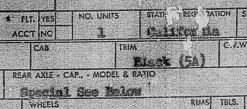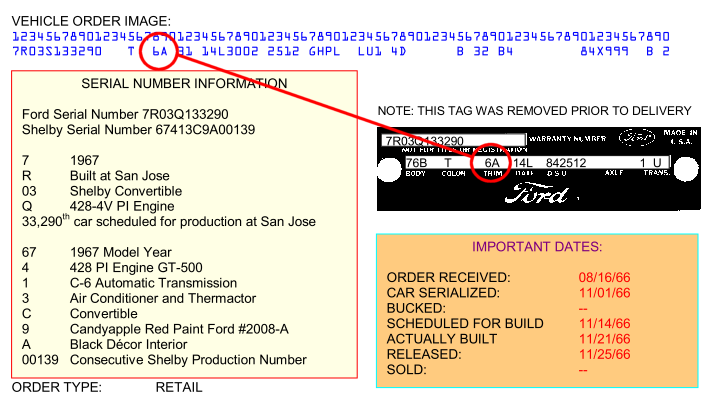How rare is the 6A Black ‘Smooth’ Vinyl Trim in a 1967 Shelby G.T. ?
Rich Plescia
We know that 1967 Shelby G.T.s were fitted with three different trim codes: 5A, 6A and 5U.
Putting color aside, did Shelby American intend to offer two different seating surface options? Was there a reason, such as A/C-equipped cars getting one material versus non-A/C cars getting the other?
The sales guides distributed to Shelby franchised dealers in anticipation of the car’s launch made no mention of different trim options. So why are there cars with both trim types?
A deep data dive is what we do best at the Shelby Research Group (SRG). We’ve embarked on another fact-finding mission and further scrutinized the DSOs and the Change Notices from the microfilm file. The DSO information was then cross-referenced to the post-build data obtained from owner-supplied Marti Reports that have been shared with us. As you may have guessed, we found some interesting data and have a couple theories we’d like to share...
First, a quick primer:
5A - Luxury Bucket Seats with Black Knitted Vinyl. The knitted vinyl seating surface has an almost perforated or performance car look to it. This is often referred to as ‘Comfortweave’, which, according to Kevin Marti, might be a Mercury trade name for the material.
6A - Luxury Bucket Seats with Black Vinyl. For lack of a better term this would be a ‘smooth’ seating surface material.
5U - Luxury Bucket Seats with Parchment Knitted Vinyl. According to a SAI memo dated 9/28/1966, a light color interior was requested by many dealers in hotter climates. The Parchment (off white color) trim fulfilled that request.
We began by looking at the DSOs obtained from microfilm. The following observations have been organized by date:
Aug. 1966 - DSOs 2501-2512 were ordered with 5A trim.
Sep. 1966 - DSOs 2513-2517 were ordered with 5A trim.
Sep. 27, 1966 - DSOs 2519, 2520, 2522 and 2523 were canceled (these were mostly GT500s with air conditioning)
Sep. 28, 1966 - Change Notices for DSOs 2513-2516, 2518, and 2521 were ‘received’ switching trim from 5A to 6A.
Oct. 13, 1966 - DSOs 2524-2527 specifically called for 6A trim. Perhaps prior to these DSOs being typed, it became evident that the 5A trim was still not going to be available. These three DSOs were the only DSOs that actually specified 6A trim.
Oct. 17, 1966 - The DSOs received in September that hadn’t been canceled, 2513, 2514, 2518 and 2521, now got canceled. (resulting in all the September orders being canceled).
Oct. 23, 1966 - With the DSO 2528 order, 5A trim resumed & continued through to the end of the fulfilled orders (DSO 2614).
Next we reviewed the post-build Ford data from Marti Reports that many car owners have shared with us. Here’s what we observed:
It seems that all cars on DSOs 2501-2527 received 6A trim, regardless of what trim was specified on the DSO order.
Some cars built in the 4th week of Jan, 1967 (ordered on DSO 2536) specified 5U Parchment trim, however, post-built data indicates some of the cars on this DSO received 5A Black trim.
A small number of late-built cars received 6A trim. So far we’ve found these cars scattered across DSOs 2608 through 2612, built at San Jose, between the dates of 6/5/67 and 7/12/67. Other cars on these same DSOs have also been found with 5A trim.
Our theory:
Based on the way the cars were ordered, per the DSO microfilm, it appears that Shelby American intended for all 1967 G.T. cars to have the 5A ‘Luxury Knitted Vinyl ’ trim. However, due to multiple issues procuring the material, not all cars received the trim they were intended to have.

DSO (from Microfilm)
In working through our theory, we identified what we believe are three (3) different material shortage events at the San Jose assembly plant:
It began at the start of production and affected approximately the first 228 cars ordered. It is our theory that the 5A ‘Black Knitted Vinyl’ material was not available yet (at least not at the San Jose assembly plant), so the ‘smooth’ 6A Black Vinyl trim was substituted instead.
With DSO 2536 cars built in early January 1967, we see ~33 cars received 5A Black trim despite being ordered with the 5U Parchment trim per their DSOs. Coincidentally, these same ~33 cars happen to be the same cars that had emissions (EECS) components added to them. We believe this was done to compensate for the 33 cars previously completed without emissions (DSOs 2534, 2538 & 2540), due to another materials shortage issue. Could it be that there was a 5U trim shortage at the same exact time as the emission shortage and affected the exact same cars? Here's the topic on the new 428 emissions engine delay/make-up explanation.
Near the end of production, it appears there was another shortage of the 5A Black Knitted Vinyl affecting ~113 cars. We believe the DSO-ordered 5A trim material was not available and the plant substituted the 6A ‘smooth’ trim material (the next closest thing). The shortage/substitution appears to be on specific build-dates, which is what allows us to suggest that this issue was related to materials shortage at the assembly plant.
In summary, we estimate that a total of 341 cars were built by Ford with the 6A Luxury 'smooth' Vinyl seating surfaces.
Note: Shelby American documents only refer to the color of the trim, “A” or “U,” not the actual material. Again, this is most-likely because SAI never intended to have two different material types. The post-build data contained in a Marti Report is the only way to confirm the ‘as built’ factory correct trim code for each car. Marti Reports also contain a DSO Item # which put the cars in a specific paint order within a DSO group. They also include the key dates as to when cars were ordered, serialized, scheduled and actually built. Combined, this information helps to define the timeline when the trim materials shortages took place at San Jose.
Now here’s where we need your help: If you happen to have one of the rare 6A-trimmed 1967 Shelby G.T.s (documented with a Deluxe Marti Report), we would very much like to hear from you. Our numbers are estimated and our theories are only as strong as the amount of paperwork that is shared with us. Our current estimate is that the late-production 5A materials shortage (cars built with 6A trim) began on on DSO 89-2608 after VIN #2800 and continued through to the end of San Jose production. With your help, we’ll be able to pinpoint exactly what days(s) the assembly line ran out of material, what day(s) they were re-supplied, and the exact quantity of cars built with 6A trim. (It would also be helpful to identify cars with 5A comfortweave trim in DSOs 2608 through 2612, to eliminate them as shortage possibilities.)
Here's where to find you car's trim code on a Deluxe Marti Report:

In the meantime, please stay tuned as we continue to test our theories, answer your questions and publish more data….
Brian Styles

Brian S
- June 5, 6, 7
- June 27, 28, 29, 30
- July 12
Rich P
Brian Glover
Rich P
Brian S
dwdietz1
Brian S
This includes both G.T. 350 and G.T. 500 models ordered on DSOs 2609, 2610, 2611, and 2612.
